1992 VOLKSWAGEN CARAVELLE belt
[x] Cancel search: beltPage 26 of 164
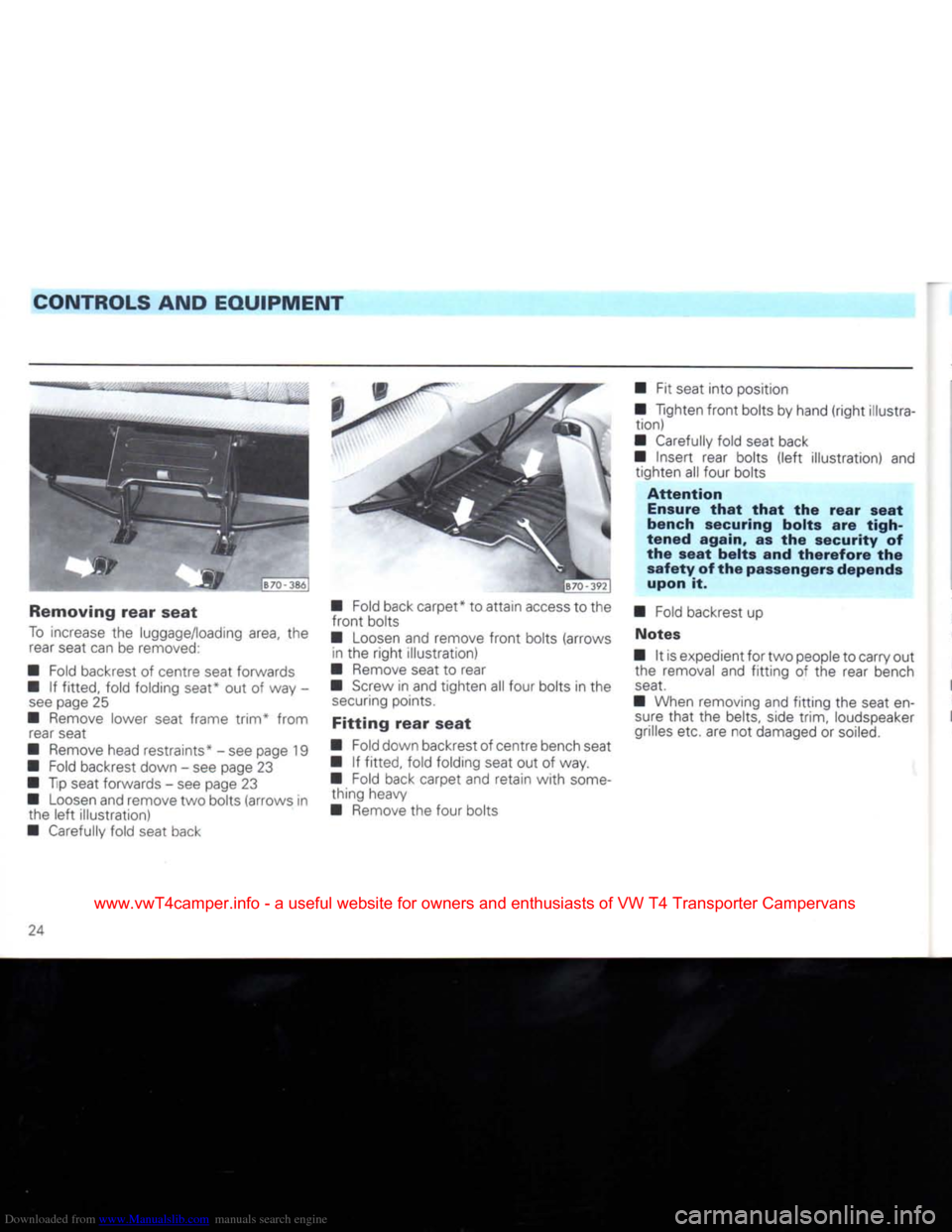
Downloaded from www.Manualslib.com manuals search engine
CONTROLS AND
EQUIPMENT
Removing
rear
seat
To
increase the luggage/loading area, the rear seat can be removed:
• Fold backrest of centre seat forwards
• If fitted, fold folding seat* out of way -
see
page 25
• Remove lower seat frame trim* from rear seat
• Remove head restraints* - see page 19
• Fold backrest down - see page 23
• Tip seat forwards - see page 23
• Loosen and remove two bolts (arrows in the
left
illustration)
• Carefully fold seat back • Fold back carpet* to attain
access
to the
front
bolts
• Loosen and remove
front
bolts (arrows in the
right
illustration)
• Remove seat to rear
• Screw in and tighten all four bolts in the securing points.
Fitting
rear
seat
• Fold down backrest of centre bench seat
• If fitted, fold folding seat out of way.
• Fold back carpet and retain
with
some thing heavy
• Remove the four bolts • Fit seat
into
position
• Tighten
front
bolts by hand
(right
illustra
tion)
• Carefully fold seat back
•
Insert
rear bolts
(left
illustration) and tighten all four bolts
Attention
Ensure
that that
the
rear
seat
bench securing
bolts
are
tigh
tened
again,
as the
security
of
the
seat
belts
and
therefore
the
safety
of the passengers
depends
upon
it.
• Fold backrest up
Notes
• It is expedient for two people to carry out the removal and
fitting
of the rear bench
seat.
• When removing and
fitting
the seat en sure
that
the belts, side trim, loudspeaker
grilles etc. are not damaged or soiled.
24
www.vwT4camper.info - a useful website for owners and enthusiasts of VW T4 Transporter Campervans
Page 27 of 164
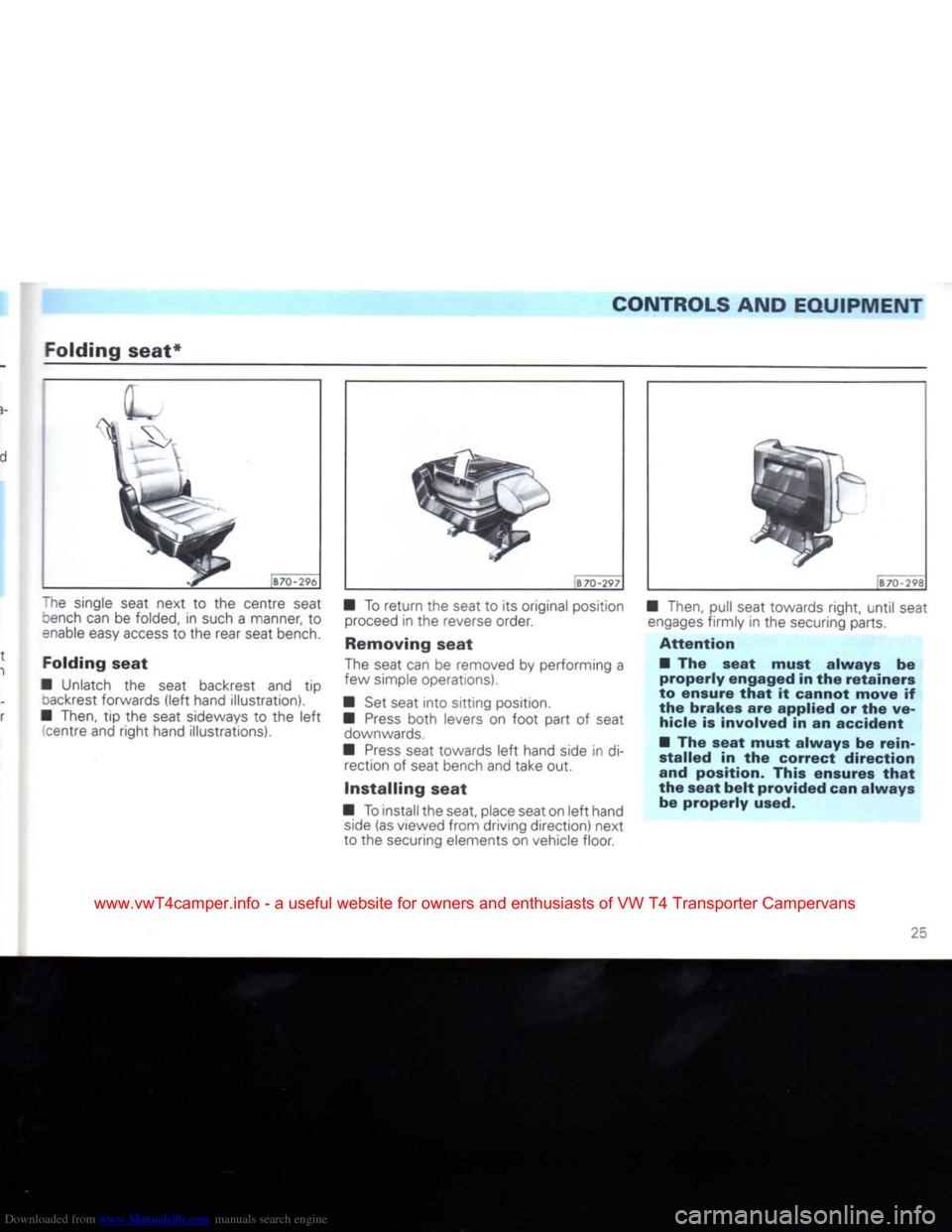
Downloaded from www.Manualslib.com manuals search engine
CONTROLS AND
EQUIPMENT
Folding
seat*
[B70-296
The single seat next
to the
centre seat oench can
be
folded,
in
such
a
manner,
to
enable easy
access
to the
rear seat bench.
Folding
seat
• Unlatch
the
seat backrest
and tip
oackrest forwards
(left
hand illustration).
• Then,
tip the
seat sideways
to the
left
centre and
right
hand illustrations).
[B70-297
•
To
return
the
seat
to its
original position proceed
in the
reverse order.
Removing
seat
The seat can
be
removed
by
performing
a
few simple operations).
• Set seat
into
sitting
position.
•
Press
both
levers
on
foot
part
of
seat downwards.
•
Press
seat towards
left
hand side
in di
rection
of
seat bench and take
out.
Installing
seat
• To install the seat, place seat on
left
hand
side
(as viewed
from
driving direction) next
to
the
securing elements
on
vehicle floor. [B
70-298
• Then, pull seat towards
right,
until
seat engages
firmly
in the
securing parts.
Attention
•
The seat must always be properly engaged in the retainers
to ensure
that
it cannot move if
the brakes are applied or the ve hicle is involved in an accident
•
The seat must always be rein
stalled in the correct direction
and position. This ensures
that
the seat
belt
provided can always be properly
used.
25
www.vwT4camper.info - a useful website for owners and enthusiasts of VW T4 Transporter Campervans
Page 30 of 164

Downloaded from www.Manualslib.com manuals search engine
CONTROLS AND
EQUIPMENT
Luggage
compartment/load
surface
To
enlarge
luggage
space
Lower
backrest and seat as described on
page 23.
Notes
on loading
In the interests of good handling ensure
that
the load (persons and luggage) is distributed evenly. Heavy items should always be carried as near to the rear axle as possible or
better still, between the
axles.
The permissible axle and gross
weights must not be exceeded under any circumstances.
Attention
• It should be noted
that
when
transporting heavy items the handling
will
change due to the
displacement of the centre of
gravity. Driving style and speed must be altered to suit.
• The load must be stowed so
that
no items of luggage can fly
forward if brakes are applied suddenly. - If necessary use the lashing
eyes.
• One should ensure
that
the heater el
ements in the rear window on the Variant
are not damaged by articles rubbing against
them.
• The stale air
escapes
through ventilation openings at the rear. The function of these openings must not be impaired.
Attention
• When vehicle is on the move no persons may be in the luggage
compartment. This includes
children.
Every passenger must
be belted in properly - see page
15.
• Never drive
with
the tailgate or
wing doors not properly closed otherwise exhaust gas can be
drawn
into
the vehicle
interior.
On
vehicles
with
lashing eyes the load
should always be secured to the
eyes.
Each
eye has a tensile strength of 500 kg.
28
www.vwT4camper.info - a useful website for owners and enthusiasts of VW T4 Transporter Campervans
Page 51 of 164

Downloaded from www.Manualslib.com manuals search engine
CONTROLS
AND
EQUIPMENT
6-Alternator
Q
~ne warning lamp comes on when the
igni-
I
on
is
switched on and must go out when
She
engine
is
started.
i the warning lamp comes on when driving,
stop,
switch
engine
off
and
check
the
alternator V-belt.
f the V-belt
is
broken or loose do not
drive
on with
a
vehicle which
has a 4 cylinder
engine
because the coolant pump
is
then
no
longer being driven. The V-belt must
be
tensioned
or
renewed.
ehicles with
a 5
cylinder engine
can
nor
mally
be
driven to the nearest Volkswagen
dealer when
the
V-belt
is
broken
or
loose oecause
the
coolant pump
is
driven separ
ately but then the battery will discharge
con
tinuously
and all
non-essential electrical consumers should
be
switched
off.
f the warning lamp comes on although
the
belt
is
not broken, one can normally drive on
to
the nearest Volkswagen dealer (all engine
types)
but the
battery will then discharge
continuously
- see
previous paragraph.
7-Glow
plugs
W
(Diesel engines only)
When
the engine
is cold
the warning lamp comes on when key
is
turned to Drive
posi
tion
(ignition on).
If
the warning lamp does not come
on,
there
is
a
defect in the glow plug system
-
call
in
expert assistance.
When
the
lamp goes out,
start
the engine
immediately
-
see page
38.
When
the
engine
is warm the
glow plug
lamp
does
not
come on -the engine can
be
started straight
away.
(®)
-
Anti-locking
Brake
System
(ABS)*
The operational readiness
of the
essential electrical components
of the ABS are
checked,
both before moving off and when
driving,
by an electronic monitoring system.
The warning lamp lights up when
the
igni
tion
is
switched on and
it
must go out again, at the latest, after the engine
has
started.
If
the warning lamp does not go out
or if it
comes on when driving the system
is
not
in
order.
The
vehicle can then only
be
braked
with
the
normal system
-
that
is
without
ABS-.The vehicle must be taken to a Volks
wagen Dealership
as
soon
as
possible.
Further details on ABS
is
given on page
30.
<]1i>
-
Trailer
turn
signals
The warning lamp
*
flashes when turn
sig
nals are switched on when towing
a
trailer.
If a
turn signal fails on the trailer or vehicle,
the warning lamp does not flash.
www.vwT4camper.info - a useful website for owners and enthusiasts of VW T4 Transporter Campervans
Page 80 of 164
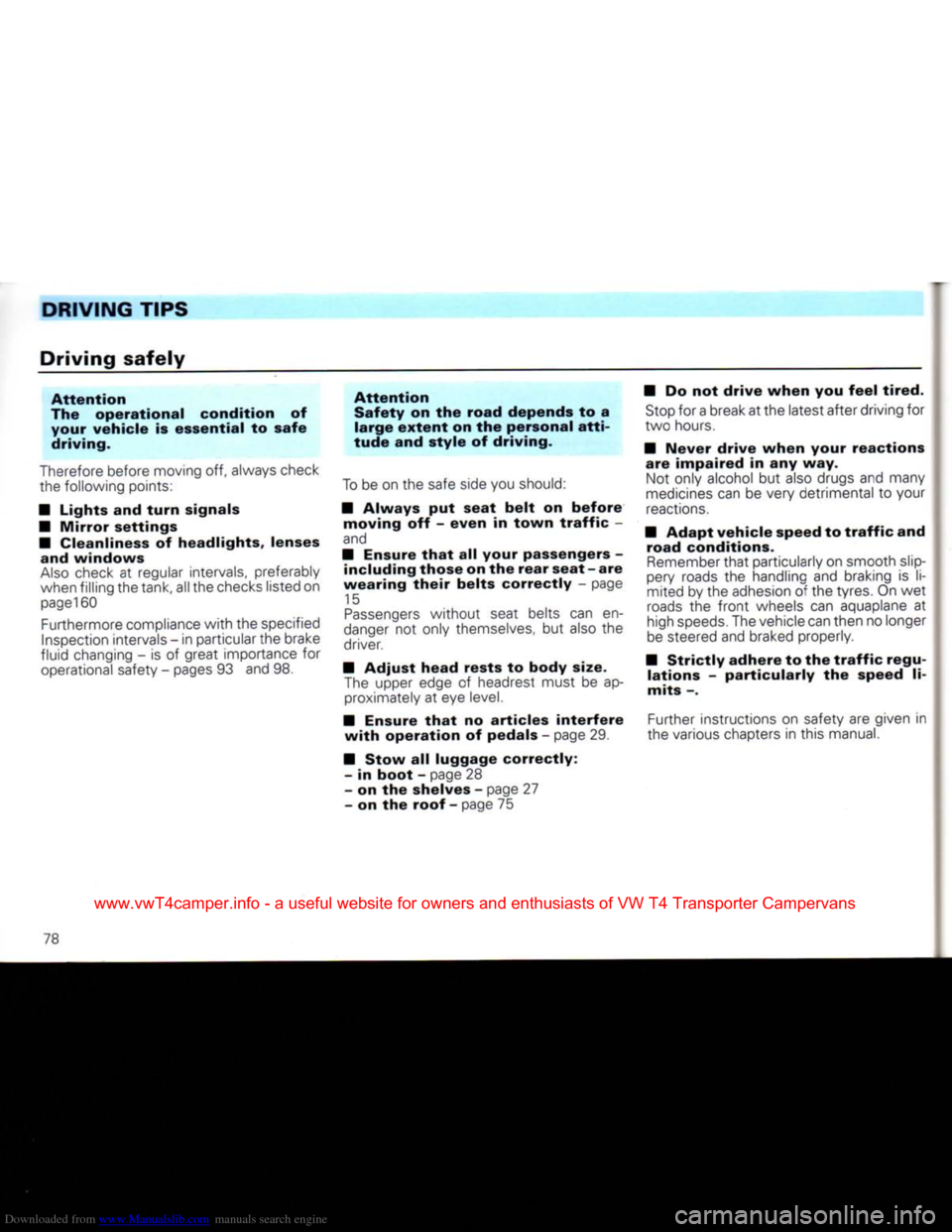
Downloaded from www.Manualslib.com manuals search engine
DRIVING
TIPS
Driving
safely
Attention
The
operational
condition of your
vehicle
is
essential
to
safe
driving.
Therefore before moving off, always check
the following points:
• Lights and
turn
signals
•
Mirror
settings
• Cleanliness of
headlights,
lenses and
windows
Also
check at regular intervals, preferably
when filling the tank, all the checks listed on
page160
Furthermore compliance
with
the specified Inspection intervals - in particular the brake
fluid changing - is of great importance for operational safety - pages 93 and 98.
Attention
Safety
on the
road
depends to a
large
extent
on the personal
atti
tude
and
style
of driving.
To
be on the safe side you should:
•
Always
put
seat
belt
on
before
moving
off -
even
in
town
traffic
-
and
• Ensure
that
all your passengers - including
those
on the
rear
seat
- are
wearing
their
belts
correctly
- page
15
Passengers
without seat belts can en
danger
not only themselves, but also the
driver.
•
Adjust
head
rests
to body size.
The
upper edge of headrest must be approximately at eye
level.
• Ensure
that
no
articles
interfere
with
operation
of pedals - page 29
•
Stow
all
luggage
correctly:
- in
boot
- page 28
- on the shelves - page 27
- on the
roof
- page 75 • Do not
drive
when
you
feel
tired.
Stop
for a break at the latest after driving for
two hours.
•
Never
drive
when
your
reactions
are
impaired
in any way. Not only alcohol but also drugs and many
medicines
can be very detrimental to your
reactions.
•
Adapt
vehicle
speed to
traffic
and
road
conditions.
Remember
that
particularly on smooth slip
pery roads the handling and braking is li
mited by the adhesion of the tyres. On wet
roads
the
front
wheels can aquaplane at
high
speeds.
The vehicle can then no longer
be
steered and braked properly.
•
Strictly
adhere
to the
traffic
regu
lations
-
particularly
the speed li
mits
-.
Further instructions on safety are given in
the various chapters in this manual.
78
www.vwT4camper.info - a useful website for owners and enthusiasts of VW T4 Transporter Campervans
Page 92 of 164
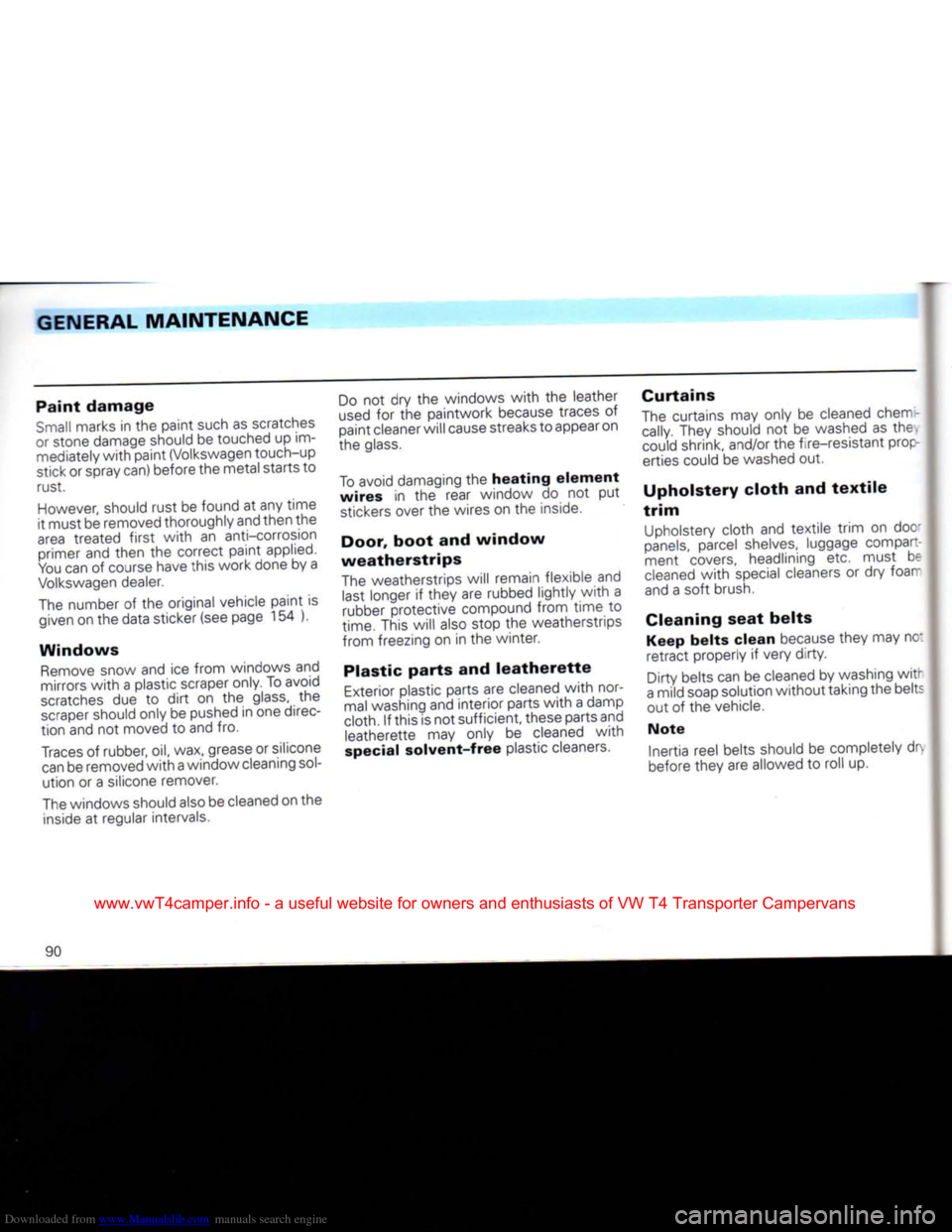
Downloaded from www.Manualslib.com manuals search engine
GENERAL MAINTENANCE
Paint damage
Small marks in the paint such as scratches
or stone damage should be touched up im mediately with paint (Volkswagen touch-up
stick or spray can) before the metal starts to rust.
However, should rust be found at any time
it must be removed thoroughly and then the
area treated first with an anti-corrosion primer and then the correct paint applied.
You can of course have this work done by a
Volkswagen dealer.
The number of the original vehicle paint is given on the data sticker (see page 154 ).
Windows
Remove snow and ice from windows and
mirrors with a plastic scraper only. To avoid
scratches due to dirt on the glass, the
scraper should only be pushed in one direc
tion and not moved to and fro.
Traces of rubber, oil, wax, grease or silicone
can be removed with a window cleaning
sol
ution or a silicone remover.
The windows should also be cleaned on the inside at regular intervals. Do not dry the windows with the leather
used for the paintwork because traces of
paint cleaner will cause streaks to appear on
the glass.
To avoid damaging the
heating element
wires
in the rear window do not put
stickers over the wires on the inside.
Door, boot
and
window
weatherstrips
The weatherstrips will remain flexible and last longer if they are rubbed lightly with a
rubber protective compound from time to
time.
This will also stop the weatherstrips
from freezing on in the winter.
Plastic parts
and
leatherette
Exterior plastic parts are cleaned with nor
mal washing and interior parts with a damp
cloth.
If this is not sufficient, these parts and leatherette may only be cleaned with
special solvent-free
plastic cleaners.
Curtains
The curtains may only be cleaned chemi cally. They should not be washed as the.
could shrink, and/or the fire-resistant properties could be washed out.
Upholstery cloth
and
textile
trim
Upholstery cloth and textile trim on doc-
panels, parcel shelves, luggage compart ment covers, headlining etc. must be
cleaned with special cleaners or dry foarr
and a soft brush.
Cleaning seat belts Keep belts clean
because they may nc:
retract properly if very dirty.
Dirty belts can be cleaned by washing with
a mild soap solution without taking the belt; out of the vehicle.
Note
Inertia reel belts should be completely dr.
before they are allowed to roll up.
90
www.vwT4camper.info - a useful website for owners and enthusiasts of VW T4 Transporter Campervans
Page 93 of 164
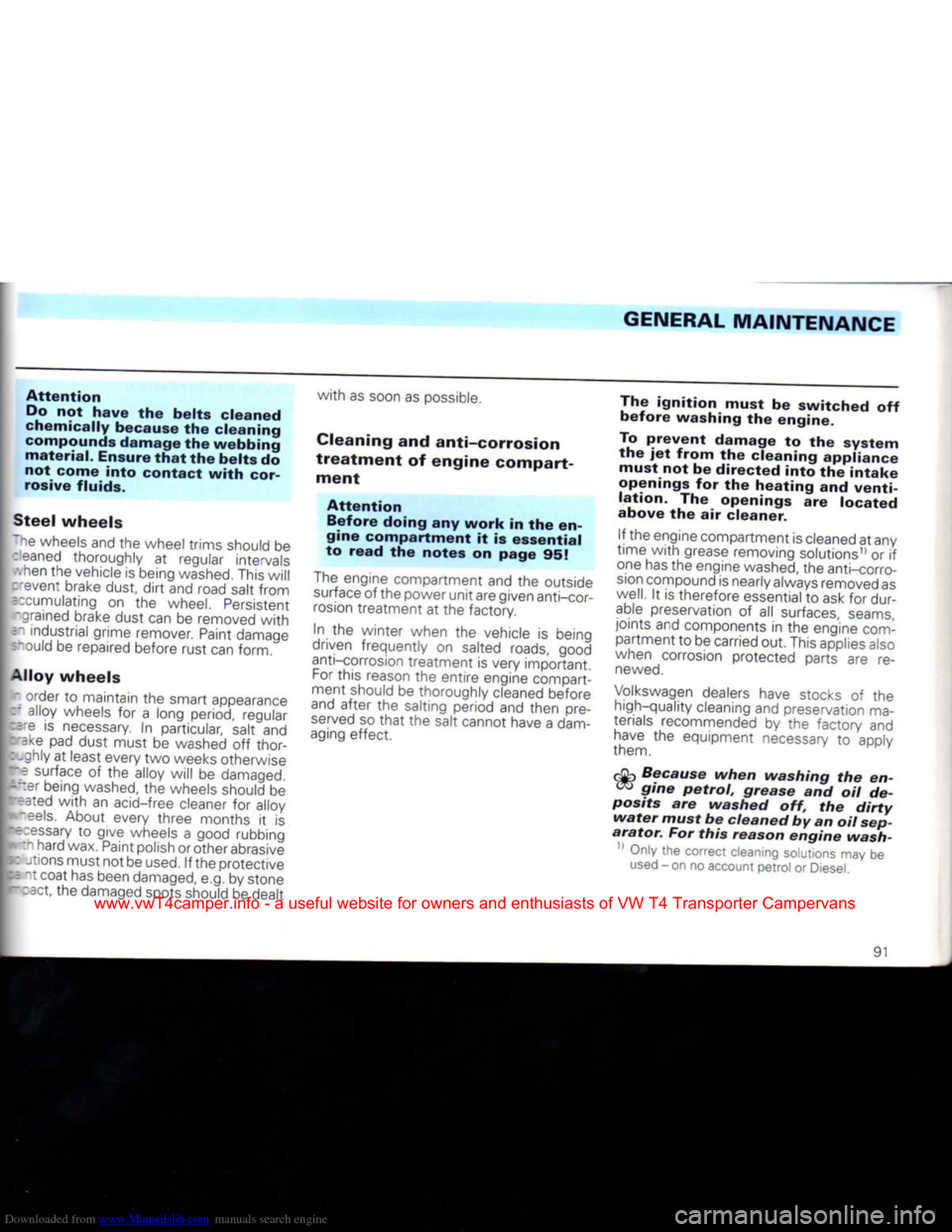
Downloaded from www.Manualslib.com manuals search engine
GENERAL
MAINTENANCE
Attention
Do
not have the belts cleaned
chemically
because the cleaning
compounds
damage the webbing
material. Ensure
that
the belts do not come into contact
with
cor
rosive
fluids.
Steel wheels
~ne wheels and
the
wheel trims should
be
:!eaned
thoroughly
at
regular intervals .'.hen the vehicle
is
being washed. This
will
"event brake dust,
dirt
and road salt
from
•cumulating
on the
wheel. Persistent "grained brake dust can
be
removed
with
="
industrial grime remover. Paint damage ;~ould
be
repaired before rust can form.
Alloy wheels - order
to
maintain
the
smart appearance
• alloy wheels
for a
long period, regular pre
is
necessary.
In
particular, salt
and
•Bke
pad dust must
be
washed
off
thor-
cghly
at
least every two weeks otherwise re surface
of the
alloy
will
be
damaged.
-~er
being washed,
the
wheels should
be
~f3ted
with
an
acid-free cleaner
for
alloy
"eels.
About every three months
it is
"f:essary
to
give wheels
a
good rubbing
». :n hard wax. Paint polish or other abrasive
•c
„tions must not be
used.
If
the protective
BE
-.t
coat has been damaged, e.g. by stone react,
the
damaged spots should be dealt
with
as soon
as
possible.
Cleaning and anti-corrosion
treatment
of
engine compart ment
Attention Before doing any
work
in the en
gine compartment it is essential
to read the notes on page 95!
The
engine compartment and
the
outside
surface
of
the power
unit
are given anti-cor
rosion treatment
at the
factory.
In
the
winter when
the
vehicle
is
being
driven frequently
on
salted roads, good
anti-corrosion treatment
is
very important.
For
this reason
the
entire engine compart
ment should
be
thoroughly cleaned before
and after
the
salting period
and
then pre
served
so
that
the
salt cannot have
a
dam
aging effect. The
ignition must be switched off
before washing the engine.
To
prevent damage to the system
the jet from the cleaning appliance must not be directed into the
intake
openings
for the heating and ventilation. The openings are located
above the air cleaner.
If
the engine compartment is cleaned
at
any
time
with
grease removing solutions1'
or if
one has the engine washed, the anti-corro
sion
compound is nearly always removed as
well.
It is
therefore essential
to
ask
for
dur
able
preservation
of all
surfaces,
seams,
joints
and components
in the
engine com partment
to
be carried out. This applies also
when corrosion protected parts
are re
newed.
Volkswagen
dealers have stocks
of the
high-quality cleaning and preservation ma
terials recommended
by the
factory
and
have
the
equipment necessary
to
apply
them.
Because
when
washing
the en
gine
petrol,
grease
and oil de
posits
are
washed
off, the
dirty
water
must
be
cleaned
by an oil
sep
arator.
For
this
reason
engine
wash-
11
Only
the
correct
cleaning
solutions may
be
used
-
on no account petrol
or
Diesel.
91
www.vwT4camper.info - a useful website for owners and enthusiasts of VW T4 Transporter Campervans
Page 97 of 164

Downloaded from www.Manualslib.com manuals search engine
GENERAL
MAINTENANCE
Engine
compartment
Page
Windscreen
washer
container
.. 108
Power
assisted
steering
fluid
reservoir*
100
Engine
oil filler
opening
97
Engine
oil
dipstick
97
Coolant
expansion
tank 102
Brake
fluid
reservoir
104
Battery
106 Attention
Particular care should be
taken
when working in the engine
com
partment!
•
Switch off engine, remove ignition key.
•
Pull handbrake on firmly.
•
Move gear lever into neutral or
"P"
position.
•
Allow engine to cool off.
•
As long as the engine is at op
erating temperature:
-
Do not put your hand into the radiator fan, it could switch on
suddenly.
-
Do not open the radiator cap be
cause
the cooling system is
under
pressure.
•
Avoid causing short circuits in
the electrical system - particular ly at the
battery
-.
•
If tests have to be
carried
out
with
the engine running,
there
is
an additional danger
present
from rotating parts - e.g.
V-belts,
generator, radiator fan etc. - and
from the high voltage ignition
system.
Attention must be paid to the warnings given in this Instruc
tion Manual and to the generally
applicable
safety regulations.
When topping up fluids one
should
ensure
that
they are not mistaken,
one
for the other, under any
circum
stances,
otherwise serious
func
tional defects
will
result.
So
that
leaks
are quickly de
tected
the ground underneath
the vehicle should be checked
reg
ularly.
If spots as caused by oil or
other
operating fluids can be seen, the vehicle should be
taken
to the
workshop for checking.
www.vwT4camper.info - a useful website for owners and enthusiasts of VW T4 Transporter Campervans